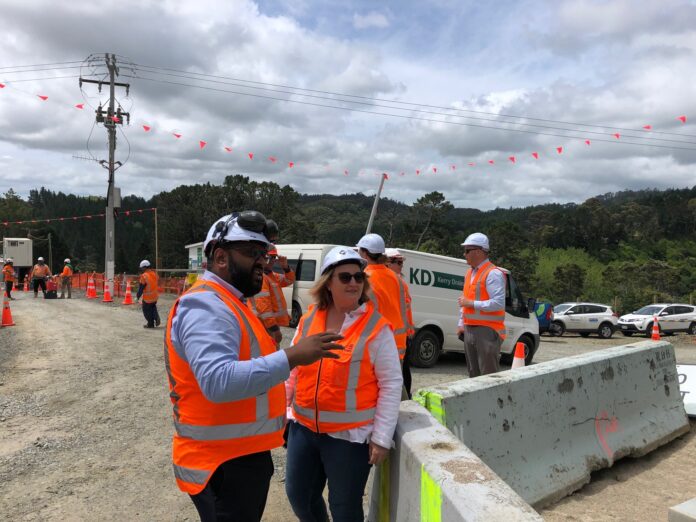Source: Auckland Council
Normally the last thing you want to hear is that your builder has only done a third of the job.
But Watercare’s $57million Hays Creek Dam project can’t be completed any other way.
With more than 100 staff on site every day, the first third of the job is almost completed, well ahead of schedule, with a temporary treatment plant capable of providing six million litres of water a day set to come online this month.
Manurewa-Papakura Auckland Councillors Daniel Newman and Angela Dalton visited the site recently to check progress.
They thanked contractors installing tanks and finishing the temporary plant, with others already piling for the permanent facility that will rise on the Hunua Road site.
Plans to recommission Hays Creek were put in place to increase the city’s regional water supply.
The one-time Papakura water treatment plant, fed from the Hays Creek Dam in the Hunua Ranges, was built in the 1950s but was taken out of service early this century when it could not meet changing drinking water standards.
Watercare took over the site in October 2020 and just 32 days later had water flowing to a temporary plant having completed a massive piping upgrade to the dam.
Head of operations Priyan Perera says despite traffic disruption piping was completed without a single complaint from residents. “We’re very proud of that. We worked to communicate as much as possible with locals and they were very understanding and supportive of our work, and completing it quickly helps.”
The water flowing from the dam to the temporary plant is treated using the latest technology and leaves as Aa-graded drinking water that fully complies with today’s standards.
Priyan says adding six million litres of water a day to Auckland’s system also lifts the operational flexibility of the city’s supply.
Councillor Newman calls the project a triumph of common sense.
“Auckland is facing a water crisis but here was an existing dam that could be returned to service at a price much lower than building from scratch.
“Auckland Council has been in discussions with neighbouring authorities and we have reached an agreement to take more water from the Waikato, but we need to take from our own local water sources too.”
Hays Creek, originally built to supply Papakura, is the smallest of all the Hunua Ranges dams yet still has an 18.2 hectare lake that holds 1.1 gigalitres of water – more than two billion large glasses of water.
Contractors will next turn their attention to demolishing the final remnants of the old plant so that the first part of a new permanent plant can rise in its place.
It too will supply six million litres of water a day, and when it is completed, the temporary plant will be taken out of service, much of it being reused in the final project stage, adding another six million litres a day capacity to the permanent plant, doubling it to 12 million litres a day.
Priyan can’t speak highly enough of his international workforce.
“It’s a big workforce of skilled people assembled from around the world. There’s a lot of technical heavy infrastructure work, there’s elaborate electrical systems, intricate filtration and water technology and so on.
“And they are working at a terrific pace, so much so that you can see real change happening quickly.”
That pace is nothing new to Watercare or its contracting partners, with a second South Auckland project, a 50 million litre reservoir near Pukekohe in Franklin also completed ahead of schedule.
Such a large workforce inevitably brings diversity, but Councillor Dalton was struck by the number of women in civil engineering management roles.
Brian Perry Civil senior project manager Kate Loveridge, an Australian with more than a decade of heavy building in China behind her, can’t even claim she’s a trailblazer, since her sister Alyssa Miller is heavily involved with the Central Inceptor project in the city, while Watercare’s senior water quality scientist is Leeanne McKenzie and the commissioning engineer Rebecca Upton-Birdsall.
All three say their organisations have been hugely supportive of adding women to the workforce.
“It’s not that long ago when you would visit a site like this and there would be no women at all, or perhaps one on the tools,” Cr Dalton says. “It’s great to visit Hays Creek and see so many women on site, but also to see them in senior and management positions.”



